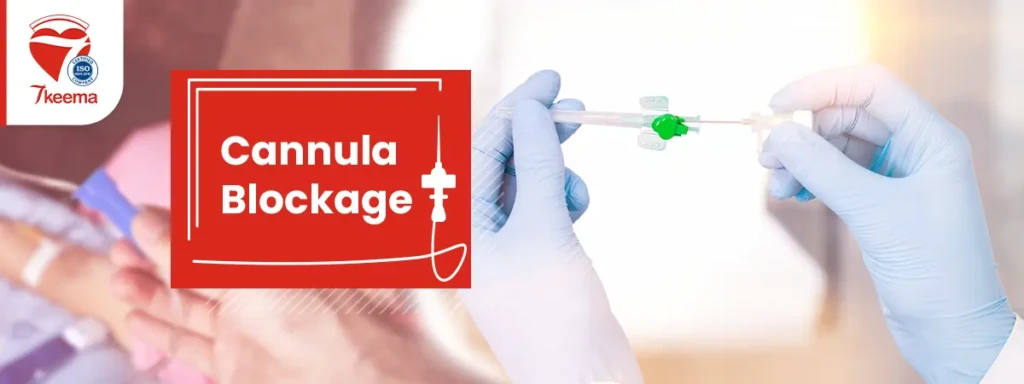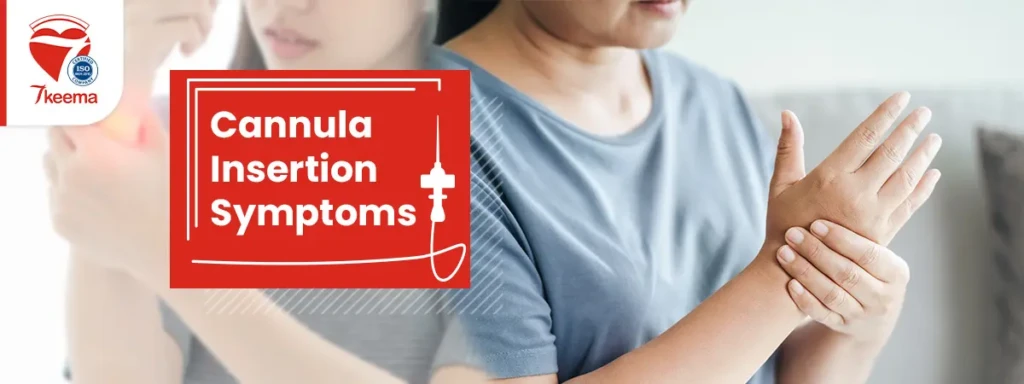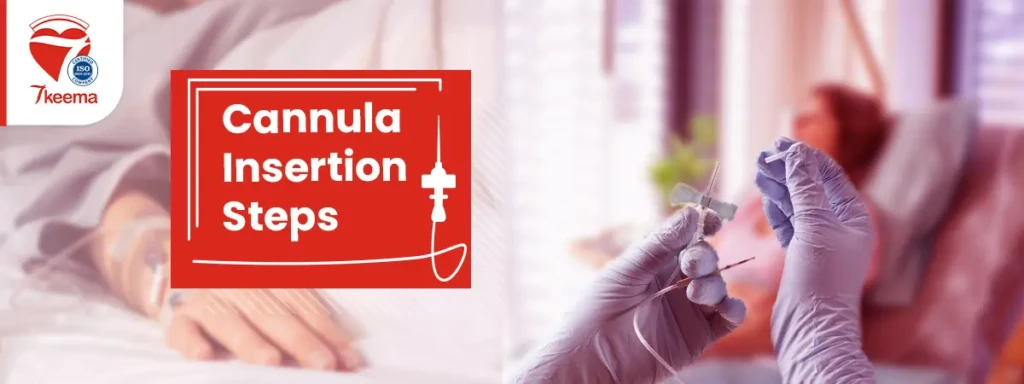The Cannula, that tiny tube that crosses the human vein to bring life to the person to whom it is attached, is necessary for any clinic, hospital, or after an operation. The Cannula is more than just a tube that allows a doctor or nursing staff to deliver IV fluids to a patient’s body. It saves lives by transfusing blood, delivering medicines into the bloodstream, and helping with intravenous feeding. So, in a nutshell, it’s more like a medical or nursing superhero, and in a few lines, we’ll go over all of that little superhero known as a technologist, his use, his harm, and everything else.

Why insert a cannula?
The Cannula has several uses and is fitted for different purposes. Their types and places of insertion vary based on three factors: age, type of disease, and the patient’s situation. As for the reasons for their general insertion, a cannula can be inserted at a hospital or home by home nursing services. We can explain them in the form of points as follows:
- body fluid loss compensation
- intravenous
- Parenteral Nutrition
- In cases of blood transfusion or blood donation
- in cases of transfusing, some blood components like platelet
- While surgeries, the Cannula delivers IV fluids and anesthesia to the body
- In the case of burns, the person is dehydrated and needs to be fitted with liquids to compensate for the loss of fluids
- Intrauterine perfusion before surgery
- Antibiotics can be given by home nursing staff
- Fluids for blood pressure
- Sometimes it is placed to re-balance the salts of the body, and home nursing services can do it
- Chemotherapy is also transferred to the body by Cannula
- Before CT or MRI, a cannula is installed to insert some medical dyes
- As for home nursing services, they also have a role in facilitating the situation for patients, for example:
1- Home nursing services that can draw blood at home
2- Home nursing services can install IV fluids through the Cannula
You can rely on 7keema for home nursing services to help you at home with cannula insertion for different purposes. If you want to read more about our home nursing services, click here.

What are the insertion places?
As mentioned before, the installation position varies, or rather we can say that its location is determined according to 3 things:
- The patient’s condition
- The type of disease
- Age
Let’s talk more about this so you can know if the nurse you are with is inserting it properly or not, and you can rely on Home Nursing from 7keema.
They are placed in many places, the most famous and the most common hand in the body. However, there are other reliable places, such as:
- Veins in the neck
- Veins in the thigh
- veins in hand more likely to be inserted at home by home nursing staff
- Veins in the arm
- In very rare and uncommon cases, the tongue is inserted into the tongue. This is a rare condition called a frog heart cannula which is resorted to in cases of blocked salivary channels because of water drainage senses. The Cannula is inserted to determine the direction of the nerve, and the vein is located below the tongue. Therefore, it is necessary to know the direction of the nerve so that it doesn’t get damaged.
Insertion places differ from each other related to:
1- Wide veins:
– Critical cases and injections that tighten the veins
– In emergency cases such as car accidents, in this case, it must be at a hospital, not by a home nursing team.
– When the patient’s condition is unstable, it is prone to deterioration.
– The possibility of a blood transfusion.
– In the case of severe dehydration, the nurse inserts IV fluids into the patient’s body intravenously (and if it is at home, you can rely on 7keema home nursing services)
– Medicines that narrow the vein.
2- Small veins:
– for patients who need an antibiotic, or for some cases where the body needs to take insulin continuously, it can be taken by home nursing staff.
Some conditions require very careful use or insertion of an intravenous cannula, whether at home or a hospital, for those patients with bleeding and convulsive disorders or patients who use medicines that increase the fluidity of blood, and the insertion is prohibited in certain medical situations, such as:

- – Veins near the site of infection
- – Spots in the veins feeding a broken limb
- – In the case of a patient suffering from dropsy in his limbs or, in other words, fluid accumulates in the body’s cells under the skin, which leads to swelling.
Dropsy has several causes, including:
- venous insufficiency
- heart failure
- Kidney problems
- Low protein level
- Liver problems
- Problems related to blood clots, such as deep vein thrombosis
- Infections
- Lymphedema
It should also be avoided to use a cannula on the side of the affected body in the event of a stroke because of the medical complications that may result, such as:
- Injury to the nerve due to incorrect insertion
- injury to the artery
- Venous infections
- Clots
- Severe pain at the injection site
- In hematoma, in this case, the Cannula is removed urgently.
In the case of being at home, home nursing services and staff from 7keema that are well-trained and at a high level of experience and competence can avoid such mistakes that endanger patients’ lives. If you want to request home nursing services or cannulation, you can count on the 7keema app.

What happens if there is a blockage in the Cannula after insertion?
After insertion, if any blockage occurs in it, an attempt must be made to drain it with 2 to 3 cm of saline solution. If the situation is not resolved, we remove it immediately, a procedure that is carried out by specialized nursing in 7keema.
We provide you with home nursing at the highest level, and it is inserted and removed by a nursing specialist experienced so that the matter is not doubled and there are no complications.
What types of cannula insertion?
It has more than one type that is used according to the patient’s age and the veins’ condition.
For example, the yellow color is used for children, newborns, and small veins, but the topic is deeper than just being colors to differentiate between them.
Let’s talk deeper into this point:
– Yellow color cannula in size 24, and it’s used for children, newborns, and small veins
– Pink Color size 20 is the most common among patients and is used for non-emergency blood transfusions
– The blue color measures 22 and is used for the elderly to transport solutions slowly and for individuals with weak veins
– Green color with size 18, and it is used in the patient’s veins during operations for easy
operations of narcotic drugs and rapid blood transfusion during surgery
– Gray color cannula, size 16, used for wounded patients who need urgent blood transfusions
– The red color is size 14 and is used for central venous catheters and is inserted in large veins
On the other hand, the factor on which the size is determined is the condition of the patient’s vein, whether it is prominent or not, and not according to age only. As a result, the nurse or home nursing staff must be fully aware of the types of veins and what type of Cannula is best for them. If you want to request home nursing for such services, you can count on 7keema.

What are the Symptoms after cannula insertion?
After the Cannula is placed, some symptoms may appear, such as pain, stiffness, or enlargement. This is an allergic reaction to the medicines that have been injected, and we can say that most cases are mild and disappear in a few hours, but we advise you to have an experienced nurse or a highly qualified home nurse until he takes some steps such as:
– Applying ice to the place where symptoms appear
– Taking pain relievers that have an anti-inflammatory effect, such as ibuprofen, after making sure that there are no contraindications.
– Avoid any attempts to put pressure on the swelling
What are the mistakes of cannula insertion?
There are several types, sizes, and different uses, as we mentioned before, and given their importance, we recommend that you refer to a specialized home nursing team from 7keema. As for the damages of incorrect installation, now we will put answers to everything that is on your mind
Faulty intravenous rate:
This is when the medicine is administered intravenously at a rate faster than the recommended rate in the Medication Guide by 15% or more. This represents the most important problem with administering the drug intravenously.
Some patients can take the drug intravenously, such as cancer patients, Alzheimer’s patients, or the elderly, who may find it difficult to swallow the drug. The nurse must suspend a solution or insert the drug into the body.
Wrong medication amount:
Using a volume of solvent or diluent to prepare an intravenous drug differs from the volume recommended by the Medication Guide.
Wrong combination:
Any use of an incorrect solvent, diluent, or additive that does not comply with the Intravenous Medication Guide.

Medication incompatibility:
This is when a drug is given with another drug or solution through the same intravenous infusion bag, and there is no documented compatibility between these drugs when given together, for example, when they are given together with furosemide and cefotaxime.
There are some other practices, such as:
1- Poor placement of the needle during cannula insertion
2- Repeated attempts to enter the cannula failure, causing tissue damage
3- Carelessly placing the tape, causing the vein to slip
4- Using a weak or small vein that is not suitable for the size of the cannula size
5- Not knowing about high-risk medications
6- Failure to monitor intravenous fluid flow
What are the complications of installing the wrong Cannula?
– infiltrate
– infection
– Air embolism as a result of entering a large number of bubbles into the patient’s vein, which may cause serious complications, including stroke
– Venous infections

What are cannula insertion steps?
The nurse must follow some steps before or during the installation of the Cannula. Here we advise the patient or one of his companions to monitor the nurse’s position on the Cannula to ensure that it is placed correctly. For example:
– The Nurse shouldn’t look for a vein using his eyes only, but he should touch the skin in a way that helps him find the veins.
– Pulling the skin steadily. All veins are circular, but some are not completely circular, especially in older people with thin skin cases. In these cases, pulling the skin is necessary. Searching and chasing the veins is not only what harms the patient, but the risk of cutting and wounding the vein during the injection, so try to pull the skin steadily below and above the place where you will be injected using the other hand.
– Using a compression belt sometimes is a bad thing. It depends on whether the vein is well visible and you can easily identify it first. If it is visible, it is better not to use the compression belt. But if you use it, be careful not to tie it tightly not to cause the vein to explode during penetration—his needle. If a tourniquet explodes while using the belt, the nurse must remove it quickly and try to install it.
Using an appropriately sized needle, as we all mentioned before, the needle size varies from person to person and from one type to another. We can shorten it again:
– The yellow Cannula measures 24.
– The pink Cannula measures 20
– The blue bottle measures 22.
– The green channel has a divisor of 18.
– The red cannula 14
– The Gray Cannula size is 16
In the end, the insertion of the Cannula or that small tube is very important for all cases, whether at home or in the hospital and should not be tolerated in any way. If you want quick services such as injections, catheters, or Cannula insertion at home, you can request a home nursing service from 7keema.
Reference:
https://www.chelwest.nhs.uk/your-visit/patient-leaflets/medicine-services/intravenous-cannulation
https://facemedstore.com/blogs/blog/types-of-cannulas-and-their-uses




